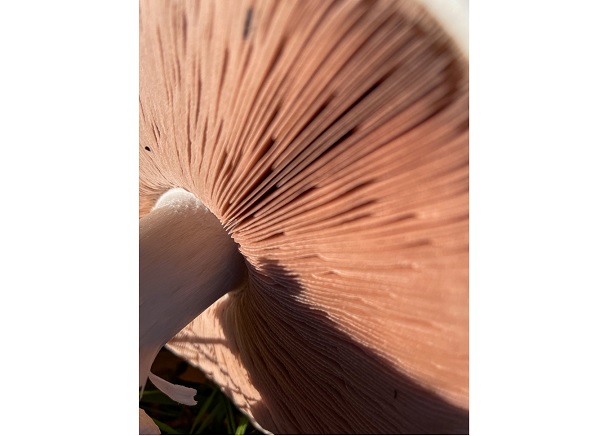 Luxembourg’s field mushroom gills;;
Credit: © Claire Schroeder
Luxembourg’s field mushroom gills;;
Credit: © Claire Schroeder
In the latest in a series of articles about current conservation issues, experts at natur&ëmwelt, a leading nature conservation NGO in Luxembourg, spoke to Chronicle.lu about all things mushroom foraging.
Natur&ëmwelt volunteer Claire Schroeder helped collect the relevant information from the NGO for this article.
Recently, mornings have become crisper and the sun is seemingly resting a bit more. Those who are looking forward to those warm yet humid days know it all too well: mushroom foraging season is here.
Chronicle.lu: So, when is the best time to go foraging?
Natur&ëmwelt: In Luxembourg, we are lucky to often have good conditions to go mushroom foraging. You're looking for humid days but with some warmth still in the air. Autumn is ideal as trees (who maintain a bi-lateral and entirely necessary relationship with mycelia, and mushrooms in turn) are going into hibernation, requiring less nutrients, which can then in turn be concentrated on the fruiting body of the mycelium - the mushroom.
Chronicle.lu: What is the difference between mycelium and mushrooms?
Natur&ëmwelt: What you would usually forage is actually just the fruiting body of the organism. The whole mushroom includes the mycelium - long, white thread-like channels that meander underground or on wood. It’s similar to picking just the fruit off of a tree.
Chronicle.lu: What does one need before going foraging?
Natur&ëmwelt: You don’t need much besides appropriate clothes and some sort of ventilated container to bring your bounty home with you. Avoid plastic bags as this can encourage fermentation. It could also be useful to bring a guide, a camera and perhaps a notebook for documenting. Also be aware that mushrooms in Luxembourg are protected and regulated. It is vital to take the time to read the regulations on the matter. However, in summary, each forager is limited to three specimens per species for study purposes and your harvest is limited to 1 kg per person per day for the listed edible species. These numbers change if you are in a group.
Chronicle.lu: How can one be sure that the mushrooms picked can be consumed?
Natur&ëmwelt: This is probably the biggest reason that people refrain from going foraging, or at least consuming what they do find. And for good reason! You might have heard that many comestible species also have doppelgangers - mushrooms that look near identical to their comestible counterpart but that are poisonous (or at least not fit for consumption). While this is true in some cases, it is more complex than that. Therefore, it is always recommended to get your foraged mushrooms checked and identified by an expert. The Groupe de Recherche Mycologique are available via email to help identify your findings through photos and if you would like to be sure your specimens are safe for consumption, you can also arrange a meeting with one of their experts.
Chronicle.lu: How do experts go about identifying different specimens?
Natur&ëmwelt: There are several physical characteristics that go into identifying an individual mushroom. Thinking of it like collecting clues in order to come to a conclusion. These clues range from the colour of the spores a mushroom releases, to the type and structure of the gills under the cap, and even their smell. In order to ensure a correct identification, it is important to remove the entire fruiting body from the ground (instead of cutting it) so that all elements are visible. It is also helpful to know the context in which the specimens were found, such as the trees in the area, as some types of mushrooms favour symbiosis with specific species of trees.
Chronicle.lu: What happens if one inadvertently consumes a poisonous mushroom?
Natur&ëmwelt: There’s definitely a spectrum here. Some specimens will make you ill in a recognisable food-poisoning type of way but will not be life threatening, while others will be life-threatening. In these cases, you will usually feel very poorly within four to eight hours after consumption before feeling slightly better again. However, during this time your liver is being attacked and at this point it is usually too late. Whatever the case, it is important to seek treatment as soon as symptoms are present, and if possible provide a sample of the mushroom consumed (whether that be in the form of food scraps or bodily waste) to enable the identification of the consumed spores and thus, a more efficient treatment plan. Keep in mind however, that even edible mushrooms can go bad and cause issues if not stored properly.
Chronicle.lu: For anyone who would like to learn more about mushrooms but finds it overwhelming, where should they start?
Natur&ëmwelt: This is completely understandable. We are lucky to have a huge range of species in Luxembourg, but this certainly does make the task of learning all about them quite daunting. While the internet and guidebooks are a very accessible inlet, not to mention an invaluable field companion (the natur&ëmwelt “Guide to the Mushrooms of Luxembourg” is a good place to start), a more hands-on way of expanding your mycological knowledge is going out with an expert. The Luxembourgish Society of Naturalists occasionally organises them, as does the Groupe de Recherche Mycologique and several nature reserves in the country.








